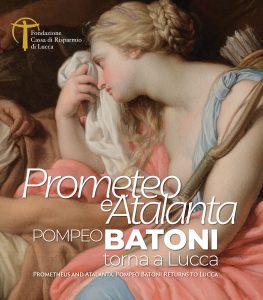 di Liliana Barroero
di Liliana Barroero
pp. 56, f.to 20,5×23,5, ill. col., bilingue ita-ing, 2022
ISBN 978-88-6550-841-1
€ 10
Due opere singolari, luminose, di una nitidezza che invita a osservare, a cercare il dettaglio nel particolare. Due opere che sono presentate al pubblico, ai Lucchesi e a tutti gli amanti dell’arte, appena entrate a far parte della collezione della Fondazione Cassa di Risparmio di Lucca. Un’occasione importante per la città: riabbracciare due tele significative nel contesto della produzione del pittore più autorevole che il nostro territorio abbia mai espresso. Commissionate proprio per una famiglia lucchese, il Prometeo e l’Atalanta rappresentano un’importantissima testimonianza del talento di Pompeo Batoni, capace di cimentarsi con tematiche varie ed estremamente colte.
Lo conosciamo infatti soprattutto come ritrattista, calato in un genere che lo ha consacrato come pittore più richiesto della Roma settecentesca, ma le sue committenze, soprattutto quelle per la ‘patria’ Lucca, ci parlano di un artista dagli interessi trasversali che seppe mettere a frutto in maniera importante e originale i lunghi anni di studi compiuti a Roma. Due tele cruciali nella produzione della prima maturità del pittore, che raccontano anche la storia di un uomo legato alla sua terra, sempre amata e sempre fonte di importanti commissioni.
Two singular works, luminous and vivid in a way that invites the viewer to observe closely, to examine the particulars. These two paintings, recently added to the collection of the Cassa di Risparmio Foundation, are now available to the public—to the citizens of Lucca and to all lovers of art. This important occasion reunites Lucca with two remarkable works of art that are representative of the oeuvre of the most masterful painter Lucca ever produced. Originally commissioned for a family in Lucca, Batoni’s Prometheus and Atalanta are a profoundly significant testimony to the artist’s talent and to his ability to foray into widely varied and highly sophisticated themes.
We may know Batoni first and foremost as a portraitist, a genre that ordained him as the most requested portrait painter of 18th-century Rome, but his commissions, particularly those originating in his birthplace, Lucca, tell us a great deal about this artist of perpendicular interests who made excellent and original use of his long years of study in Rome. These two canvases mark a crucial moment in Batoni’s early maturity as a painter. What is more, they tell us the story of a man deeply connected to his home, a city he had always and would always love and a source of noteworthy patrons.




Comments are closed.